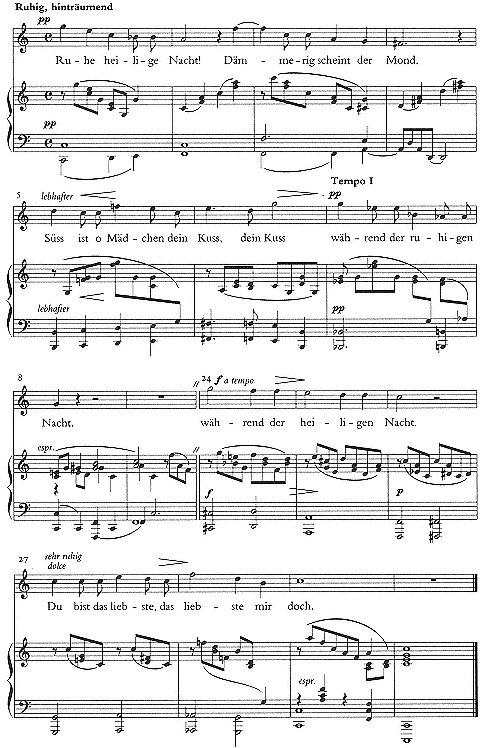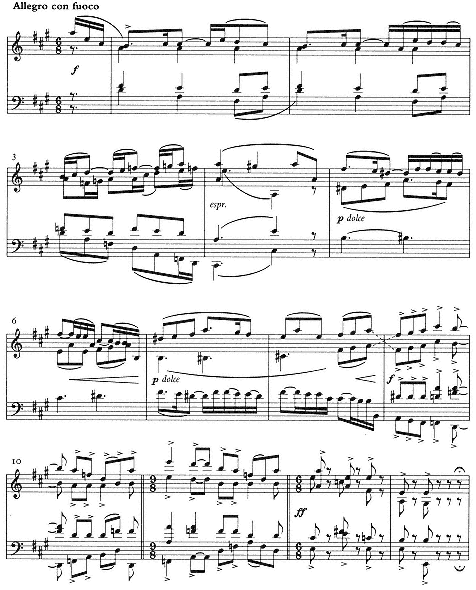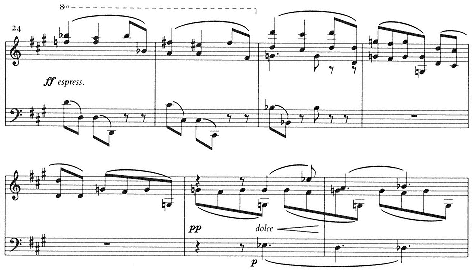Zemlinsky
Alexander von Zemlinsky (1872–1942), who in the period 1895–97 or 1896–97 became Schoenberg's only teacher in composition (we can be sure of neither the
[5] Schoenberg fought hard to retain this title, about which the original publishers at Philosophical Library were not enthusiastic (see McGeary 1986, 184–88). The concept of a musical "idea," which Schoenberg reformulated many times, was to find its most complete exposition in a large manuscript, which remained unfinished, entitled "Der musikalische Gedanke und die Logik, Technik und Kunst seiner Darstellung." A scholarly edition of this work, the so-called Gedanke manuscript, will appear as Schoenberg 1994. For a survey of its contents, see Goehr 1977. On the various possible meanings of "idea" in Schoenberg's writings, see Cross 1980.
[6] It is possible that Schoenberg's strong reaction against "style" as both a creative tool and critical yardstick was owing to his proximity in Vienna to the music historian Guido Adler (with whom he actually shared students, including Webern and Wellesz). Adler's highly influential methodological studies (see, for example, Adler 1911) form part of a much broader phenomenon of style consciousness among both practitioners and critics of the arts at the end of the nineteenth century. In German-speaking areas, especially, the visual arts and architecture were dominated by the notion of Stilkunst and of art having its own "will to style" (Stilwollen). In art history these concepts were given their strongest formulation by the Viennese curator and writer Alois Riegl, whose ideas are discussed by Schapiro (1953, 301–2) and Alpers (1987, 140–47); Riegl had a powerful influence on his compatriot and contemporary Adler. There is no evidence of animosity on Schoenberg's part toward Adler's method. (On the relationship and surviving correspondence between Schoenberg and Adler, see Reilly 1982, 99–100.) The composer may nevertheless later have felt that the contemporary obsession with "style" was excessive and misdirected.
exact dates nor the content of the instruction), was one of the most promising young musicians in Vienna in the the last decade of the century. After an auspicious study period at the Conservatory under such Brahms cronies as Anton Door and Robert Fuchs, he served as a conductor in several Viennese theaters and opera houses (including a stint under Gustav Mahler at the Hofoper in 1907) and was widely admired as pianist and accompanist. In 1911 he moved to Prague as opera director of the German theater.[7]
In his early Viennese period, Zemlinsky was fully, and willingly, enveloped in the "Brahms fog." In his brief memoir of Brahms, he reports: "I remember how even among my colleagues it was considered particularly praiseworthy to compose in as 'Brahmsian' a manner as possible. We were soon notorious in Vienna as the dangerous 'Brahmins'" (Zemlinsky 1922, 70). Zemlinsky recalls that he had first been introduced to the master in 1895.[8] In the following year, Brahms took enough interest in a string quintet by Zemlinsky to invite the younger composer around to his apartment to discuss it (a devastating experience, described vividly in Zemlinsky's memoir). Shortly thereafter, at a competition of the Wiener Tonkünstlerverein, Zemlinsky's Clarinet Trio in D Minor won the third prize, for which Brahms himself had put up the money. This time, Brahms thought highly enough of the composition to recommend it to his own publisher, Fritz Simrock, in a letter that also praised Zemlinsky as "a human being and a talent" (Brahms 1908–22, 4: 212). Simrock issued the Clarinet Trio as Zemlinsky's op. 3 in 1897.
The period of Zemlinsky's personal contact with Brahms and of his most ardently Brahmsian works coincided directly with the beginning of his own relationship with, and instruction of, Schoenberg. These compositions thus merit careful consideration by anyone interested in Schoenberg's early development.[9] It is striking that the compositions of the more accomplished and highly trained Zemlinsky, although echt- Brahms in "style," actually show less real understanding of Brahms than the best works by the more intuitive, largely self-taught Schoenberg. We can see this phenomenon better by examining a small sampling—one song and one movement of a string quartet—from Zemlinsky's Brahms period.
Zemlinsky was proud enough of the song Heilige Nacht to place it at the head of his first collection of Lieder, op. 2, published in 1897 (see ex. 1.1). The anonymous poem, a hymn of praise to night, which covers everything in a cloak of
[7] For further biographical information on Zemlinsky, see Weber 1977.
[8] The occasion was the premiere of Zemlinsky's Orchestral Suite at a concert of the Gesellschaft der Musikfreunde on 18 March. Brahms led his own Academic Festival Overture in the same program. The event is described in Kalbeck 1904–14, 4: 400–401.
[9] A recent comprehensive study of Zemlinsky's early chamber works is contained in Loll 1990.

Example 1.1
Alexander von Zemlinsky, Heilige Nacht , op. 2, no. 1.
tranquility ("even sorrow is sweet"), is of a type that attracted Brahms strongly.[10] The characteristics of Zemlinsky's song that derive from Brahms are (to this listener) so palpable that they can be itemized:
· the broad, descending triadic melody, mm. 1–4. Cf. Brahms's Sehnsucht, op. 49, no. 3, where the slow ascending arpeggios of the opening are inverted in the faster middle section. There are also ascending arpeggios at the opening of Wie Melodien zieht es mir, op. 105, no. 1, and Maienkätzchen, op. 107, no. 4.
· the strong, stepwise bass line, especially in mm. 1–6. Cf. Dein blaues Auge, op. 59, no. 8.
· the arpeggiated figuration in the right hand of the accompaniment, which is shaped as a diminution of the vocal rhythm and motives, mm. 1–8. Cf. Mein wundes Herz, op. 59, no. 7. (On this technique of "harmonic congruence," see Cone 1990.)
· the dip toward the subdominant at the very beginning, mm. 1–2. Cf. An ein Veilchen, op. 49, no. 2, where, however, the tonic root remains in the bass underneath the subdominant triad. (See also the discussion of sub- and pre-dominant chords in Brahms's intermezzi below.)
· the sudden move by third, from a G to an





· the extension or augmentation of "während der heiligen Nacht" to create an irregular three-measure phrase, mm. 24–26. Cf. the augmentation of the phrase "tonreichen Schall" in An die Nachtigall, op. 46, no. 4, mm. 5–7.[11]
· the strong plagal cadence at the end of the song, mm. 29–30. Cf. the final cadence of Die Mainacht.
[10] At least twelve of Brahms's works are set to such texts, including (in alphabetical order) Der Abend, op. 64, no. 2; Abenddämmerung, op. 49, no. 5; Abendregen, op. 70, no. 4; An den Mond, op. 71, no. 2; Dämmrung senkte sich von oben, op. 59, no. 1; Gestillte Sehnsucht, op. 91, no. 1; In stiller Nacht, WoO 33, no. 42; Die Mainacht, op. 43, no. 2; Mondenschein, op. 85, no. 2; Mondnacht, WoO 21; O schöne Nacht! op. 92, no. 1; and Sommerabend, op. 85, no. 1.
[11] This and other examples of such phrase extension in Brahms's songs were pointed out admiringly by Schoenberg in "Brahms the Progressive" (Schoenberg 1975, 418–22).
Despite the distinguished, documentable pedigree of its technical devices, Zemlinsky's Heilige Nacht comes across as a pallid imitation of the master. First, the phrase structure is uncomfortably square. The rather rigid succession of two-measure units in the opening section, through m. 8, is scarcely concealed by the small modifications, such as in m. 6, where Zemlinsky repeats the words "dein Kuß" in order to extend the phrase another half measure. There is little here of the subtle asymmetry fundamental to Brahms's language. Nor would Brahms himself have undermined what is supposed to be a magical moment, the shift to the

Despite its apparent resemblance to Brahms, the harmonic syntax of Heilige Nacht also betrays awkwardness. Instead of an inflection toward the subdominant such as we might find in a Brahms song, the IV chord in m. 2 appears in root position; it is too emphatic, bringing the harmonic motion to a virtual standstill. Zemlinsky's actual cadence to F in mm. 8–9, though perhaps intended as a fulfillment of the opening harmonic gesture, is also unconvincing. The tonic has barely been reestablished in m. 7 when it is transformed into an augmented chord that is made to function as a dominant. The augmented sonority with an added seventh sounds especially bizarre in the prevailingly consonant context.
If I seem to be too hard on what is in many outward respects an attractive song, it is to point up that Zemlinsky is good at appropriating superficial stylistic traits from Brahms without really absorbing his fundamental compositional principles. This aspect of Zemlinsky's musical personality was recognized by Theodor Adorno, who in his penetrating essay of 1959 suggests that Zemlinsky was a genuine eclectic, "someone who borrows all possible elements, especially stylistic ones, and combines them without any individual tone" (Adorno 1978, 351). Adorno tries to strip the term eclectic of its pejorative connotations, arguing that Zemlinsky was in fact something of a genius in his "truly seismographic capacity to respond to all the temptations with which he allowed himself to be inundated" (354). I would argue that this "seismographic" receptivity actually prevented Zemlinsky from absorbing the essence of Brahms. He registered the aftershocks, so to speak, but failed to locate the epicenter of the tremor.
The same tendency can be seen in the first movement of Zemlinsky's String Quartet in A Major, which was published by Simrock as op. 4 in 1898. In the
[12] See, e.g, the perceptive analysis of such techniques in the song Feldeinsamkeit in Schmidt 1983, 146–54.
first group (ex. 1.2), the notated meter








In his commentary on this movement, Rudolf Stephan has suggested that "rhythmic complications of this kind point to the model of Brahms, who, however, does not employ them in this (almost) systematic fashion" (Stephan 1976, 128). The parenthetical "almost" betrays an appropriate diffidence, for I would maintain that there is little that is truly systematic in Zemlinsky's procedures. Indeed, it is Brahms who is more "systematic," if also more restrained, as can be shown by a brief comparative glance at the first movement of his Third Quartet in





To return for a moment to Zemlinsky's A-Major Quartet: Brahmsian symptoms are also evident in the ostentatious invertible counterpoint in mm. 5–6 and 7–8, and especially in the way in which the cadential neighbor-note motive of m. 4 (ex. 1.2) is taken up again in the transition to the second group (ex. 1.4). Here the motive, which sounds in


Brahms is the direct inspiration for this whole procedure. Indeed, Zemlinsky must have had the first movement of the Second Symphony in his ears: his neighbor-note figure bears a distinct resemblance to Brahms's basic motive,


Example 1.2
Zemlinsky, String Quartet No. 1 in A Major, op. 4, 1.

Example 1.3
Johannes Brahms, String Quartet No. 3


Example 1.4
Zemlinsky, String Quartet No. 1 in A Major, op. 4, 1.
the neighbor-note figure and its triadic companion in diminution and then moves the latter into the background to become the accompaniment for the new theme. At precisely the analogous moment in the sonata form, Zemlinsky adopts this same technique using the neighbor-note motive.
The conclusion to be drawn from these analyses may seem self-evident: no one could compose Brahms as well as Brahms himself. But I am suggesting that a superbly equipped composer like Zemlinsky can actually manage to sound very like Brahms—as he put it, "to compose in as 'Brahmsian' a manner as possible"—without showing a deeper grasp of what "Brahmsianness" really is or could be.